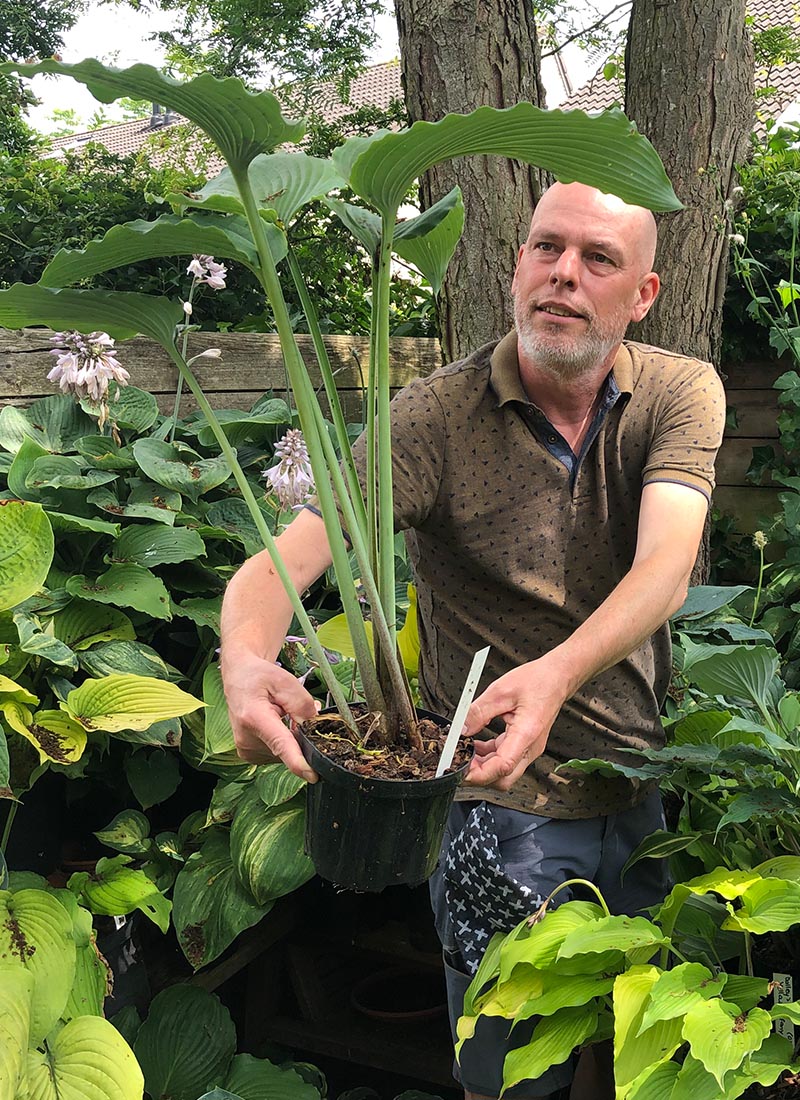Hosta Fickle Blue Genes
- Plant Size:
- Large
- Flower Color:
- Lavender
- Product Code:
- H1697
- Supplied as:
- bare roots
Availability: Out of stock
The following product is out of stock for this moment. Notify me, when this product is again available.
Hosta 'Fickle Blue Genes' is one of the most beautiful hostas ever introduced, making it a prized addition to any hosta garden. Created by renowned breeder Ed Elslager in 2000, this medium to large hosta cultivar features a striking blend of blue-green leaves streaked with shades of yellow and cream. The round, corrugated leaves have a slightly shiny finish on top and a glaucous bloom underneath, creating a unique and captivating texture. The wavy, rippled leaf edges add elegance to its upright form.
Growing to a height of 50 cm and a width of 80 cm, hosta 'Fickle Blue Genes' is not only an eye-catching perennial for shady areas but also one of the most fertile hostas, making it a valuable asset for hosta breeders. Its fertility has led to the creation of remarkable offspring, solidifying its reputation as a breeding standout. With near-white, lavender-striped flowers appearing in July, this hosta is more than just ornamental; it is a powerful addition to any breeder’s collection. If you’re looking for a hosta that is both beautiful and fertile, hosta 'Fickle Blue Genes' is the perfect choice for your shade garden or breeding program.
How to grow hostas
Save light shade to shade place in your garden to plant hostas. Filtered sun is best for the colorful varieties to reach their full color contrast. The green and blue hostas are the most shade-tolerant. Usually the yellow cultivars are the most sun-tolerant. The most dangerous is a direct sunshine, especially hot afternoon sun. This is the most critical where temperatures are high. Variegated varieties, especially those with a lot of white in the leaves, burn very easily. Blue color of leaves turns to green-blue or even fully green with too much direct sun. Plants with thick leaves are better suited for dry soil conditions than thin-leaved ones, but none is able to grow years-long in very dry soil. Plant hostas in moist, humus-rich soil. Water your hostas well immediately as you plant them. Give them water regularly during their first one or two growing season. Hostas grow slowly and may take 2 to 5 years to reach their full size, longer for the largest species and cultivars. Reserve a plenty of space in your perennial bed for hostas. Most of them are medium sized or large perennials. Hostas are almost fully disease and pest resistant. The most dangerous injury can by caused by slugs, snails and deers.
| Plant Size | Large |
|---|---|
| Spacing (h x w) | 50 cm x 80 cm |
| Leaf Size | 33 x 25 cm |
| Growth Rate | Fast |
| Leaf Color | Streaked |
| Leaf Color (Center) | No |
| Leaf Color (Margin) | No |
| Red "legs" | No |
| Slug Resistant | Yes |
| Sun Tolerant | No |
| Flower Color | Lavender |
| Wavy Leaf | Yes |
| Flower Fragrance | No |
| Sun Exposure | Partial Shade |
| Hybridized by | Ed Elslager |
| Year of Registration | 2000 |
| Supplied as | bare roots |
| YT Video | No |
| Bohemia | No |
| Valley's | No |
| Hanjas | No |
| Asian | No |
| Giantland | No |
No video available.




























